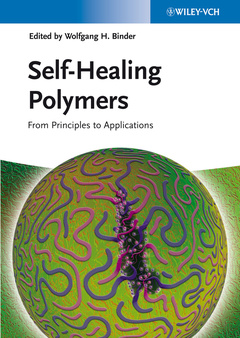Self-Healing Polymers From Principles to Applications
Coordonnateur : Binder Wolfgang H.

The book combines the knowledge of an international panel of experts in the field and provides the reader with chemical and physical concepts for self-healing polymers, including aspects of biomimetic processes of healing in nature.
It shows how to design self-healing polymers and explains the dynamics in these systems. Different self-healing concepts such as encapsulated systems and supramolecular systems are detailed. Chapters on analysis and friction detection in self-healing polymers and on applications round off the book.
PART ONE: Design of Self-Healing Materials
PRINCIPLES OF SELF-HEALING POLYMERS
Introductory Remarks
General Concept for the Design and Classification of Self-Healing Materials
Physical Principles of Self-Healing
Chemical Principles of Self-Healing
Multiple versus One-Time Self-Healing
Resume and Outlook
SELF-HEALING IN PLANTS AS BIO-INSPIRATION FOR SELF-REPAIRING POLYMERS
Self-Sealing and Self-Healing in Plants: A Short Overview
Selected Self-Sealing and Self-Healing Processes in Plants as Role Models for Bio-Inspired Materials with Self-Repairing Properties
Bio-Inspired Approaches for the Development of Self-Repairing Materials and Structures
Bio-Inspired Self-Healing Materials: Outlook
MODELING SELF-HEALING PROCESSES IN POLYMERS: FROM NANOGELS TO NANOPARTICLE-FILLED MICROCAPSULES
Introduction
Designing Self-Healing Dual Cross-Linked Nanogel Networks
Designing 'Artificial Leukocytes' That Help Heal Damaged Surfaces via the Targeted Delivery of Nanoparticles to Cracks
Conclusions
PART TWO: Polymer Dynamics
STRUCTURE AND DYNAMICS OF POLYMER CHAINS
Foreword
Techniques
Structure
Dynamics
Application to Self-Healing
Conclusions and Outlook
PHYSICAL CHEMISTRY OF CROSS-LINKING PROCESSES IN SELF-HEALING MATERIALS
Introduction
Thermodynamics of Gelation
Viscoelastic Properties of the Sol-Gel Transition
Phase Separation and Gelation
Conclusions
THERMALLY REMENDABLE POLYMERS
Principles of Thermal Healing
Inorganic-Organic Systems
Efficiency, Assessment of Healing Performance
Conclusions
PHOTOCHEMICALLY REMENDABLE POLYMERS
Background
Molecular Design
Reversible Photo-Crosslinking Behaviors
Evaluation of Photo-Remendability
Concluding Remarks
MECHANOPHORES FOR SELF-HEALING APPLICATIONS
Introduction
Mechanochemical Damage
Activation of Mechanophores
Mechanochemical Self-Healing Strategies
Conclusions and Outlook
CHEMISTRY OF CROSSLINKING PROCESSES FOR SELF-HEALING POLYMERS
Introduction
Extrinsic Self-Healing Materials
Intrinsic Self-Healing Materials
Concluding Remarks and Future Outlook
PREPARATION OF NANOCAPSULES AND CORE-SHELL NANOFI BERS FOR EXTRINSIC SELF-HEALING MATERIALS
Selected Preparation Methods for the Encapsulation of Self-Healing Agents
Mechanically Induced Self-Healing
Stimuli-Responsive Self-Healing Materials
Novel Approaches and Perspectives
PART THREE: Supramolecular Systems
SELF-HEALING POLYMERS VIA SUPRAMOLECULAR, HYDROGEN-BONDED NETWORKS
Introduction
Dynamics of Hydrogen Bonds in Solution
Supramolecular Gels
Self-Healing Bulk Materials
Conclusions
METAL-COMPLEX-BASED SELF-HEALING POLYMERS
Stimuli-Responsive Metallopolymers
Self-Healing Metallopolymers
Summary and Outlook
SELF-HEALING IONOMERS
Introduction
Basic Principles of Ionomers
Ionomers in Self-Healing Systems
Actual Developments and Future Trends in Ionomeric and Related Self-Healing Systems
PART FOUR: Analysis and Friction Detection in Self-Healing Polymers: Macroscopic, Microscopic and Nanoscopic Techniques
METHODS TO MONITOR AND QUANTIFY (SELF-) HEALING IN POLYMERS AND POLYMER SYSTEMS
Introduction
Visualization Techniques
Healing of Mechanical Properties
Healing of Functional Integrity
Summary
SELF-HEALING EPOXIES AND THEIR COMPOSITES
Introduction
Capsule-Based Healing System
Vascular-Based Healing Systems
Intrinsic Healing Systems
Conclusions
SELF-HEALING COATINGS
Introduction into Self-Healing Coatings
Concept of Micro- and Nanocontainer-Based Self-Healing Coatings
Types of Nanocontainers
Characterization of Nanocontainer-Based Self-Healing Coatings
Conclusions and Current Trends
APPLICATION OF SELF-HEALING MATERIALS IN AEROSPACE ENGINEERING
General Considerations
Conclusions
INDEX
Date de parution : 08-2013
Ouvrage de 446 p.
17.5x24.6 cm
Thèmes de Self-Healing Polymers :
Mots-clés :
time; merges; phenomenon; broken; wellknown; bone; selfhealing; skin; regenerate; order; materials; polymeric; ability; concept; aerospace; already; applications; engineering; mechanisms; field; different; nature; proven; research; fascinating



